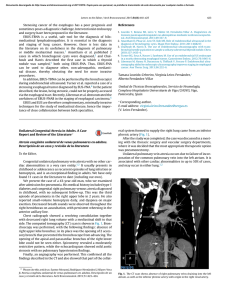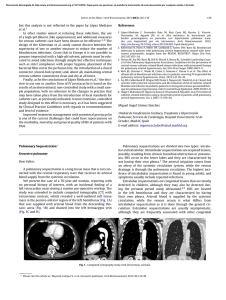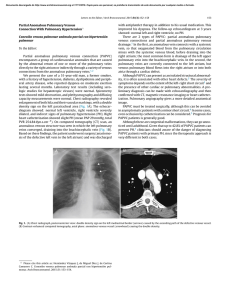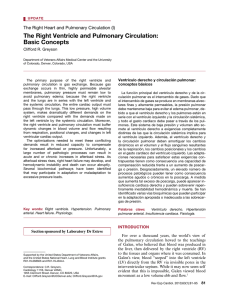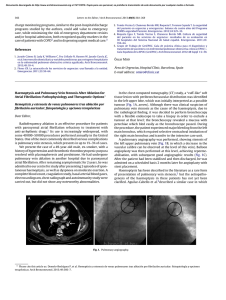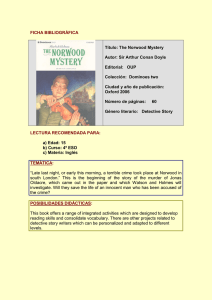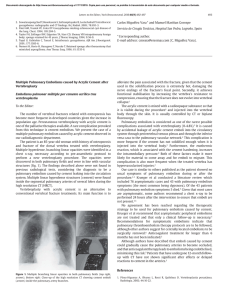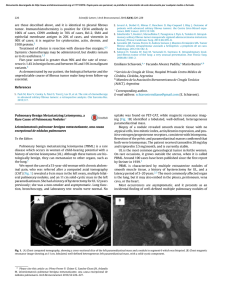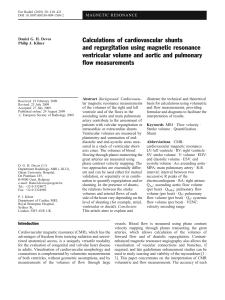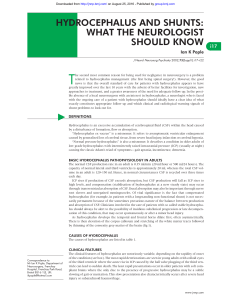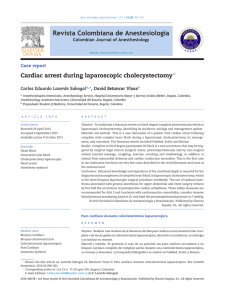- Wiley Online Library
Anuncio
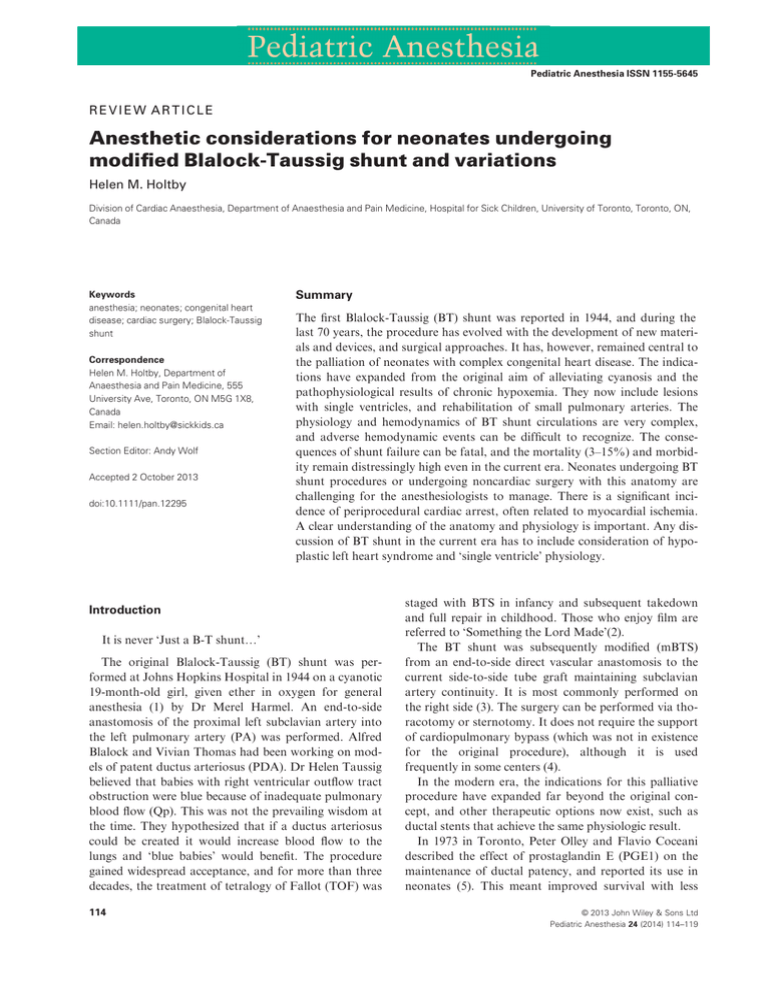
Pediatric Anesthesia ISSN 1155-5645 REVIEW ARTICLE Anesthetic considerations for neonates undergoing modified Blalock-Taussig shunt and variations Helen M. Holtby Division of Cardiac Anaesthesia, Department of Anaesthesia and Pain Medicine, Hospital for Sick Children, University of Toronto, Toronto, ON, Canada Keywords anesthesia; neonates; congenital heart disease; cardiac surgery; Blalock-Taussig shunt Correspondence Helen M. Holtby, Department of Anaesthesia and Pain Medicine, 555 University Ave, Toronto, ON M5G 1X8, Canada Email: helen.holtby@sickkids.ca Section Editor: Andy Wolf Accepted 2 October 2013 doi:10.1111/pan.12295 Summary The first Blalock-Taussig (BT) shunt was reported in 1944, and during the last 70 years, the procedure has evolved with the development of new materials and devices, and surgical approaches. It has, however, remained central to the palliation of neonates with complex congenital heart disease. The indications have expanded from the original aim of alleviating cyanosis and the pathophysiological results of chronic hypoxemia. They now include lesions with single ventricles, and rehabilitation of small pulmonary arteries. The physiology and hemodynamics of BT shunt circulations are very complex, and adverse hemodynamic events can be difficult to recognize. The consequences of shunt failure can be fatal, and the mortality (3–15%) and morbidity remain distressingly high even in the current era. Neonates undergoing BT shunt procedures or undergoing noncardiac surgery with this anatomy are challenging for the anesthesiologists to manage. There is a significant incidence of periprocedural cardiac arrest, often related to myocardial ischemia. A clear understanding of the anatomy and physiology is important. Any discussion of BT shunt in the current era has to include consideration of hypoplastic left heart syndrome and ‘single ventricle’ physiology. Introduction It is never ‘Just a B-T shunt…’ The original Blalock-Taussig (BT) shunt was performed at Johns Hopkins Hospital in 1944 on a cyanotic 19-month-old girl, given ether in oxygen for general anesthesia (1) by Dr Merel Harmel. An end-to-side anastomosis of the proximal left subclavian artery into the left pulmonary artery (PA) was performed. Alfred Blalock and Vivian Thomas had been working on models of patent ductus arteriosus (PDA). Dr Helen Taussig believed that babies with right ventricular outflow tract obstruction were blue because of inadequate pulmonary blood flow (Qp). This was not the prevailing wisdom at the time. They hypothesized that if a ductus arteriosus could be created it would increase blood flow to the lungs and ‘blue babies’ would benefit. The procedure gained widespread acceptance, and for more than three decades, the treatment of tetralogy of Fallot (TOF) was 114 staged with BTS in infancy and subsequent takedown and full repair in childhood. Those who enjoy film are referred to ‘Something the Lord Made’(2). The BT shunt was subsequently modified (mBTS) from an end-to-side direct vascular anastomosis to the current side-to-side tube graft maintaining subclavian artery continuity. It is most commonly performed on the right side (3). The surgery can be performed via thoracotomy or sternotomy. It does not require the support of cardiopulmonary bypass (which was not in existence for the original procedure), although it is used frequently in some centers (4). In the modern era, the indications for this palliative procedure have expanded far beyond the original concept, and other therapeutic options now exist, such as ductal stents that achieve the same physiologic result. In 1973 in Toronto, Peter Olley and Flavio Coceani described the effect of prostaglandin E (PGE1) on the maintenance of ductal patency, and reported its use in neonates (5). This meant improved survival with less © 2013 John Wiley & Sons Ltd Pediatric Anesthesia 24 (2014) 114–119 H. M. Holtby hypoxic injury for the babies and more and better sleep for surgeons and anesthesiologists. Long-term PGE1 infusions have been used to palliate infants listed for heart transplantation or to defer surgery to allow for growth. There are significant side effects including gastric outlet obstruction, pseudo Bartter’s syndrome and hyperostosis, particularly of digital bones (6). The development of coronary stents enables the same physiological result as a BTS in the cardiac catheterization laboratory. Stents can be deployed in the PDA permitting the discontinuation of PGE1. This may avoid a surgical incision, but there are anatomic variations in the ductus in patients with CHD which can make it impossible from a percutaneous approach (7). The placement of ductal stents as part of hybrid palliation of hypoplastic left heart syndrome (HLHS) is frequently performed via sternotomy (8) Recent publications on the outcomes of mBTS patients report distressingly high mortality and morbidity in neonates. Exclusion of patients undergoing the Norwood procedure or pulmonary arterioplasty (as surrogates for complexity) still reveals a significant incidence of adverse outcomes. In both single center and multicenter investigations, the mortality in single ventricle patients is around 15%, and in patients with two ventricles, it is 3–5% (4,9). This is higher than many neonatal cardiac repairs. McKenzie and colleagues (10) identified sternotomy, anatomic site, use of cardiopulmonary bypass (CPB), and Ebstein’s anomaly as risk factors for death. In the multicenter analysis performed by Petrucci and others (4), risk factors for death were weight <3 kg, preoperative ventilation, single ventricle palliation, and specifically, pulmonary atresia with intact ventricular septum. One-third of deaths occurred in the first 24 h postoperatively. Indications for Blalock-Taussig shunt There are fundamentally three reasons to perform a B-T shunt or its equivalent (i.e., a ductal stent) on a neonate: 1 Blood flow to the lungs is provided via the PDA: The baby will die of hypoxia if the duct closes. 2 Blood flow to the body is provided via PDA: The baby will die of systemic shock or myocardial ischemia if the duct closes. 3 The pulmonary arteries are small, and there is an attempt to encourage growth by increasing flow. Typical examples of the first situation include tricuspid atresia, pulmonary atresia, and TOF when there is a contraindication to complete repair. Neonatal Ebstein’s anomaly with functional pulmonary atresia is a rare © 2013 John Wiley & Sons Ltd Pediatric Anesthesia 24 (2014) 114–119 Anesthesia for modified BTS indication. The current strategy of early primary repair means that BT shunts are generally performed in complex situations, either anatomically (aberrant coronary anatomy) or physiologically (prematurity, intracerebral bleed, or other contraindication to CPB). It is also an option if other anomalies require evaluation or repair. Some centers choose to do BTS rather than neonatal TOF repair in those patients who are very desaturated when the duct closes. Hypoplastic left heart syndrome (HLHS) constitutes the second example. The Norwood operation is aortic arch reconstruction, PDA ligation, and mBTS. In the Norwood procedure, the mBTS provides the route for pulmonary blood flow and is intended to be the resistance component. In the ‘Hybrid procedure’, as an alternative palliation, the arch is unrepaired, favoring flow to the pulmonary arteries via the stented duct. Bilateral pulmonary bands are therefore placed to limit pulmonary blood flow, improving systemic perfusion. The third example is pulmonary atresia, VSD with aortopulmonary collaterals and inadequate pulmonary arteries. In any of the diagnoses presented, there are surgical and pharmacological and catheter-based options, and pediatric anesthesiologists will be involved at some or several stages of the child’s care. There are different considerations depending on the surgical procedure and the cardiac diagnosis. Physiology of Blalock-Taussig shunts The physiology of circulations incorporating mBTS is complex. The complications depend on factors such as ventricular size and morphology, the presence of more than one source of pulmonary blood flow, the size and position of the aortic arch, and the presence of antegrade flow through the aortic valve. Two ventricles are generally better than one (and left better than right if not). If there is more than one route for pulmonary perfusion, (such as pulmonary stenosis rather than atresia, or aortopulmonary collaterals) the effects of shunt stenosis or thrombosis are attenuated. However, the possibility of shunt occlusion may be increased if there is another route for PBF, and the possibility of too much PBF may be increased. If there is pulmonary atresia (either functional or anatomic), and no collaterals, shunt occlusion results in sudden death from hypoxemia. The most robust circulation is the original indication (now least performed), where there is inadequate pulmonary blood flow and TOF. In this situation, both ventricles eject into great vessels, although there is right ventricular outflow tract obstruction, and right to left shunt in the ventricles. The primary issues are volume 115 Anesthesia for modified BTS loading of the heart, coronary steal, and shunt thrombosis. Volume loading of the heart can cause A-V valve regurgitation and is a particular problem in single ventricles. The potential for coronary steal exists (because of blood flow diverted into the low-pressure pulmonary vascular bed) causing myocardial ischemia, arrhythmias, acute ventricular dysfunction, and sudden death. This may be exacerbated by increased ventricular enddiastolic pressure. It may be preceded by low diastolic blood pressure which is an indicator of high pulmonary to systemic blood flow ratio (Qp:Qs). Diastolic blood pressures of less than 30 mmHg are a cause for concern and close observation. A useful initial strategy is to employ maneuvers which increase PVR, such as reducing minute ventilation, and higher PEEP levels. In the longer term, there is a concern for the development of increased pulmonary vascular resistance (which can be unilateral) or pulmonary hypertension. In patients with small pulmonary arteries, the effectiveness of the mBTS in improving oxygen delivery may be limited and under those circumstances hypoxia is a major concern. In HLHS and variants, the total cardiac output emerges from the heart and diverts either into the pulmonary vascular bed or the systemic circulation. There are multiple opportunities for circulatory collapse, and for occult reductions in systemic oxygen delivery, myocardial ischemia, and inadequate systemic perfusion. In the absence of flow from the left ventricle (aortic valve or mitral valve atresia), blood exits the heart via the PA and flows right to left via the duct, and then passes retrograde around the aortic arch The coronary arteries are a very long way back from the perfusing (right) ventricle. Right-sided ventricles are more likely to dilate in the context of volume loading (which is inherently greater in single ventricle hearts). Tricuspid valve regurgitation occurs frequently and causes further inefficiency in oxygen delivery. Changes in systemic or pulmonary vascular resistance cause changes in pulmonary and systemic blood flow (Qs). Reduction in Qs because of increased Qp will tend to be self-perpetuating: vasoconstriction is a normal physiologic response to hypotension, and this may become catastrophic. Barnea and others have made mathematical models to try to understand and predict the changes in oxygen delivery (DO2) that occur with changes in Qp, Qs, and cardiac output (CO) (10,11). Such models illustrate the dilemmas facing the clinician (12). It is difficult to diagnose physiological derangements using currently available monitors. To summarize some of the originally observations from the model for the Norwood circulation (i.e., ‘single ventricle physiology’) described by Barnea: 116 H. M. Holtby 1 Arterial saturation is an unreliable guide to oxygen delivery. It is possible to have significant reduction in oxygen delivery in association with no change or modest increases in SaO2. 2 Decreases in pulmonary vein saturation cause major errors in estimates of Qp/Qs. It will be underestimated. This is a common problem in the operative period. 3 If there is high PBF, hence high Qp/Qs, there is only limited compensation in DO2 with increasing CO. These papers are important for the clinician because they describe the multiple assumptions made using routine monitors. They improve our understanding of oxygen delivery, cardiac output, Qp/Qs in complex circulations. Even the models use assumptions, mixed venous saturation is a theoretical construct in hearts with shunts. In two ventricle hearts without a shunt, the adequacy of cardiac output and oxygen delivery and consumption can be ascertained using measured mixed venous saturation, classically from the PA. There is no such point in the body to make measurements in complex CHD. The use of near-infrared spectroscopy for measurement of tissue oxygenation is used as additional monitoring of infants with complex CHD (13), but not everyone is convinced (14,15). Skepticism has also been expressed about the benefits of pulse oximetry, but most anesthetists would be extremely unhappy to practice without it despite the limitations (see 1 above!) (16). Measurement of oxygen consumption and calculation of Qp and Qs have also improved our understanding of the hemodynamics of single ventricles (17). The clinician caring for the child with a BT shunt has to ascertain whether indicators of adverse hemodynamics are real, significant and then diagnose the cause (18). The desaturated, hypotensive neonate may have: hypovolemia and low hemoglobin, which will result in very low venous saturations in combination with low CO; shunt occlusion and hypoxic cardiac failure; or high pulmonary vascular resistance and low systemic vascular resistance. They may also have respiratory disease and low pulmonary vein saturation. On the other hand, the child with high saturation and hypotension may have a high cardiac output and vasodilation, or be vasoconstricted and minutes away from cardiac arrest. The possibility of myocardial ischemia, low cardiac output, inadequate intravascular volume, primary pulmonary disease, shunt failure, iatrogenic causes and changes in systemic or pulmonary vascular resistance, and oxygen carrying capacity must be considered in all situations. This is before contemplating the effects of surgical manipulations. The reason to delineate these possibilities is to point out that neither hemodynamics © 2013 John Wiley & Sons Ltd Pediatric Anesthesia 24 (2014) 114–119 H. M. Holtby nor saturation are very good indicators of adequate systemic oxygen delivery. Anesthetic management of the neonate undergoing BTS Odegard and colleagues reviewed their experience with cardiac arrest in children undergoing cardiac surgery over a 5-year period from 2000 to 2005 (19). The incidence of cardiac arrest during closed cardiac surgery was highest in patients undergoing mBTS for pulmonary atresia, with a frequency of 3.6/100. This is higher than the Norwood procedure (2.2/100). The majority of anesthesia related arrests in children undergoing cardiac surgery were attributed to myocardial ischemia. Petrucci and colleagues analyzed the outcomes of neonatal mBTS using the Society for Thoracic Surgeons (STS) Database (4). They assessed 1280 patients from 70 institutions. The mortality was 7.2%. One-third of the deaths occurred in the first 24 h postoperatively. Preoperative acidosis, mechanical support (either ventilatory or circulatory), renal impairment, diagnosis, and weight were associated with the risk of death. Weight under 3 kg and preoperative shock were risk factors for morbidity (mechanical support, reoperation, low cardiac output). Pulmonary atresia with intact ventricular septum was the diagnosis of note. The use of cardiopulmonary bypass for mBTS appeared to have no impact on mortality or morbidity. McKenzie and colleagues reviewed the experience at Texas Children’s Hospital over a 15-year period ending in 2011. A total of 712 patients had 730 mBTS procedures. The median age of patients was 8 days. The hospital mortality was 3.4% with two ventricles, and 15% with one. They identify sternotomy as a risk factor for death. The preoperative evaluation of a neonate presenting for BTS should include the anatomic diagnosis and the surgeon’s plan. Details such as aortic arch anatomy, and the possibility of aberrant subclavian artery are important. The use of CPB, sternotomy, or thoracotomy changes the anesthetic plan for the baby and the conversation with the parents. There are also all the usual considerations of neonatal physiology and the possibility of other anomalies, as well as genetic syndromes to consider. The anesthetic considerations for hybrid palliation are described by Naguib et al. (20). The authors comment on the differences between the Norwood operation and this alternative. Sadly, the long-term outcomes are not different (21). The importance of preoperative shock on postoperative outcome makes the perinatal history important. There are fetal screening programs for CHD, and there © 2013 John Wiley & Sons Ltd Pediatric Anesthesia 24 (2014) 114–119 Anesthesia for modified BTS remains debate on the effectiveness of such interventions (22). The timely administration of PGE1 avoids the possibility of duct-related cardiovascular collapse, which is a good thing for the individual patient. The vast majority of newborns have PGE1 infusions running on presentation for surgery. The usual dose is 0.01– 0.1 mcgkg 1min. The outcome data alone on these patients prescribe invasive monitoring. We proceed as for a procedure with cardiopulmonary bypass (arterial line, generally left sided, i.e., not the shunt side, central line, NIRS). Particular attention should be paid to the baseline ECG trace and the diastolic blood pressure. The ordinary anesthetic routines, such as the use of fiO2 of 1.0 for intubation, a tendency to hyperventilate if anxious, (the practitioner, not the patient!), and anesthetic vapors all tend to decrease PVR, increase Qp/Qs, and decrease diastolic blood pressure with the resultant concerns for myocardial ischemia and systemic perfusion. A balanced anesthetic technique, combining narcotic and vapor supplemented with muscle relaxant is usually undertaken. Desaturation is relatively frequent when the pulmonary end of the anastomosis is being undertaken as the pulmonary artery is clamped. Paradoxically, this may be less of an issue via thoracotomy, as clamping the PA will reduce ventilation perfusion mismatch. It is our practice generally to discontinue prostaglandin infusions when the duct is ligated. Blood should be immediately available. If irradiated blood is not routinely provided for neonates, the suspicion of 22q11 deletion should prompt a specific request. Hemodynamic instability can ensue when the shunt is opened, due to blood loss or the changes in blood flow that is, some of the systemic flow diverts to the PA. It is common to see low saturations initially, and this can probably be attributed to high PVR and pulmonary vein desaturation secondary to lung collapse, hypoxic pulmonary vasoconstriction, and atelectasis. Transesophageal echocardiography is undertaken to assess function and shunt flow. Direct flow probes can also be used. NIRS monitoring on the head and flank may also provide guidance for management. An fiO2 of at least 30% is preferable, and more oxygen may be required in the short term. The intraoperative decisions are focused first on technical issues: is the shunt the right size, not kinked, and not narrowed. A shunt which is too short or too large, in concert with a low pCO2 and high fiO2 will have a high saturation and low diastolic blood pressure. It is wise to check arterial blood gases at this point. If there are no anatomic issues, a review of the physiologic issues is performed: adequate preload, sinus rhythm, good contractility (therefore by deduction reasonable myocardial perfusion), reasonable SVR, and 117 Anesthesia for modified BTS H. M. Holtby appropriate PVR. Even though the shunt itself is a component of PVR, it is not the sole determining factor, so changes in lung volume, alveolar oxygenation, pH, and pCO2 will affect Qp (23). The use of inotropes may improve hemodynamic parameters and oxygen delivery but at the expense of increased consumption (24). Postoperative pain is most commonly managed with continuous narcotic infusion. While early extubation has benefits for many patients following cardiac surgery, the physiological vulnerability of neonates, particularly those with CHD, is a risk. The changes in PVR, SVR, and Qp which occur with lung re-expansion in combination with emergence from anesthesia, transition to postoperative pain regimens, possible bleeding etc., all contribute to the postoperative risk of cardiac arrest. The incidence of failure to extubate neonates following mBTS was investigated by Gupta and colleagues (25). They found that 27% patients required either re-intubation or the instigation of noninvasive ventilation within 96 h. Decreased ventricular function was strongly associated with failure. There was a 13% incidence of diaphragmatic paralysis, all in the group that failed. Postextubation hemodynamics also changed, with an increase in heart rate and systemic blood pressure in successful subjects. Noncardiac surgery and mBTS The child with palliated complex CHD who requires surgery for other anomalies is at a higher risk of cardiac arrest and death (26,27). This is multifactorial and includes patient-related factors and there may be practitioner errors. Many of the babies have feeding intolerance, and oral aversion, and present for gastric tube insertion. There is also a significant incidence of neurological injury prompting requests for MRI scans. Shunt thrombosis is a constant concern despite the use of acetylsalicylic acid, clopidogrel, or low molecular weight heparin. If shunt occlusion is suspected, urgent echocardiography is indicated along with high inspired oxygen, volume, and the use of systemic vasoconstricting drugs. Emergency cardiac catheterization is indicated if there are concerns about shunt patency or pulmonary artery anatomy. The use of NIRS can be helpful, and blood gas measurements can also be revealing. Consideration should be given to intensive care unit admission postoperatively for all patients, regardless of procedure. When Helen Taussig challenged Alfred Blalock in 1943 and the subsequent surgery was undertaken, the mortality of most CHD was 50–100%. Seventy years later, that mortality is around 5%. It never was ‘Just a BT shunt’, but in previous eras when operative mortality for infants having open heart surgery was between 10 and 20%, the results of mBTS seemed much more acceptable. A significant population of patients with tetralogy of Fallot diluted the numbers of single ventricle and PA IVS patients, and HLHS was not even on the agenda. To quote Mckenzie and colleagues: ‘Despite the naive stance, yet often stated, “It’s just a shunt,” the authors maintain that construction of a proper mBTS in a neonate, via either sternotomy or thoracotomy, is an intellectually and technically challenging operation’. This is equally true for the anesthesiologists managing the neonates in the operating room or in the critical care unit. Ethical approval There is no requirement for ethical approval or consent for this article. Funding This research was carried out without funding. Conflict of interest No conflicts of interest declared. Reference 1 Blalock A, Taussig HB. The surgical treatment of malformations of the heart in which there is pulmonary stenosis or pulmonary atresia. JAMA 1945; 128: 189–202. 2 http://www.imdb.com/title/tt0386792/. HBO Director Joseph Sargent: starring Alan Rickman, Mos Def, Mary Stuart Masterson, Kyra Sedgewick. 3 Klinner W, Pasini M, Schaudig A. Anastomosis between systemic and pulmonary arteries with the aid of plastic prostheses in cyanotic heart diseases. Thoraxchirurgie 1962; 10: 68–75. 118 4 Petrucci O, O’Brien SM, Jacobs ML et al. Risk factors for mortality and morbidity after the neonatal Blalock-Taussig shunt procedure. Ann Thorac Surg 2011; 92: 642–651. 5 Olley PM, Coceani F, Bodach E. E-type prostaglandins: a new emergency therapy for certain cyanotic congenital heart malformations. Circulation 1976; 53: 728–731. 6 T alosi G, Katona M, R acz K et al. Prostaglandin E1 treatment in patent ductus arteriosus dependent congenital heart defects. J Perinat Med 2004; 32: 368–374. 7 Alwi M. Stenting the patent ductus arteriosus in duct-dependent pulmonary circulation: techniques, complications and follow-up issues. Future Cardiol 2012; 8: 237–250. 8 Caldarone CA, Benson L, Holtby H et al. Initial experience with hybrid palliation for neonates with single-ventricle physiology. Ann Thorac Surg 2007; 84: 1294–1300. 9 McKenzie ED, Khan MS, Samayoa AX et al. The Blalock-Taussig shunt revisited: a contemporary experience. J Am Coll Surg 2013; 216: 699–704. © 2013 John Wiley & Sons Ltd Pediatric Anesthesia 24 (2014) 114–119 H. M. Holtby 10 Barnea O, Santamore WP, Rossi A et al. Estimation of oxygen delivery in newborns with a univentricular circulation. Circulation 1998; 98: 1407–1413. 11 Hsia TY, Cosentino D, Corsini C et al. Modeling of congenital hearts alliance (MOCHA) investigators. Use of mathematical modeling to compare and predict hemodynamic effects between hybrid and surgical Norwood palliations for hypoplastic left heart syndrome. Circulation 2011; 11(Suppl): S204–S210. 12 Yuki K, Emani S, DiNardo JA. A mathematical model of transitional circulation toward biventricular repair in hypoplastic left heart syndrome. Anesth Analg 2012; 115: 618–626. 13 Johnson BA, Hoffman GM, Tweddell JS et al. Near-infrared spectroscopy in neonates before palliation of hypoplastic left heart syndrome. Ann Thorac Surg 2009; 87: 571–577. 14 Kasman N, Brady K. Cerebral oximetry for pediatric anesthesia: why do intelligent clinicians disagree? Pediatr Anesth 2011; 21: 473–478. 15 Hirsch JC, Charpie JR, Ohye RG et al. Near infrared spectroscopy (NIRS) should not be standard of care for postoperative management. Semin Thorac Cardiovasc Surg Pediatr Card Surg Annu 2010; 13: 51–54. © 2013 John Wiley & Sons Ltd Pediatric Anesthesia 24 (2014) 114–119 Anesthesia for modified BTS 16 Pedersen T, Hovhannisyan K, Møller AM. Pulse oximetry for perioperative monitoring. Cochrane Database of Syst Rev 2009. Art. No.: CD002013. doi: 10.1002/14651858. CD002013.pub2. 17 Li J. Systemic oxygen transport derived by using continuous measured oxygen consumption after the Norwood procedure-an interim review. Interact Cardiovasc Thorac Surg 2012; 15: 93–101. 18 Koziol J, Gertler R, Manlhiot C et al. The effect of intraoperative hypotension on the outcomes of initial hybrid palliation for single ventricle congenital heart disease: an historical cohort study. Can J Anaesth 2013; 60: 465–470. 19 Odegard KC, DiNardo JA, Kussman BD et al. The frequency of anesthesia-related cardiac arrests in patients with congenital heart disease undergoing cardiac surgery. Anesth Analg 2007; 105: 335–343. 20 Naguib AN, Winch P, Schwartz L et al. Anesthetic management of the hybrid stage 1 procedure for hypoplastic left heart syndrome (HLHS). Pediatr Anesth 2010; 20: 38–46. 21 Knirsch W, Liamlahi R, Hug MI et al. Mortality and neurodevelopmental outcome at 1 year of age comparing hybrid and Norwood procedures. Eur J Cardiothorac Surg 2012; 42: 33–39. 22 Sharland G. Fetal cardiac screening and variation in prenatal detection rates of congenital heart disease: why bother with screening at all? Future Cardiol 2012; 8: 189–202. 23 Li J, Zhang G, McCrindle BW et al. Profiles of hemodynamics and oxygen transport derived by using continuous measured oxygen consumption after the Norwood procedure. J Thorac Cardiovasc Surg 2007; 133: 441–448. 24 Li J, Zhang G, Holtby H et al. Adverse effects of dopamine on systemic hemodynamic status and oxygen transport in neonates after the Norwood procedure. J Am Coll Cardiol 2006; 48: 1859–1864. 25 Gupta P, McDonald R, Goyal S et al. Extubation failure in infants with shunt-dependent pulmonary blood flow and univentricular physiology. Cardiol Young 2013; 18: 1–9. 26 Ramamoorthy C, Haberkern CM, Bhananker SM et al. Anesthesia-related cardiac arrest in children with heart disease: data from the pediatric perioperative cardiac arrest (POCA) registry. Anesth Analg 2010; 110: 1376–1382. 27 Steven JM. Congenital heart disease and anesthesia-related cardiac arrest: connecting the dots. Anesth Analg 2010; 110: 1255–1256. 119

